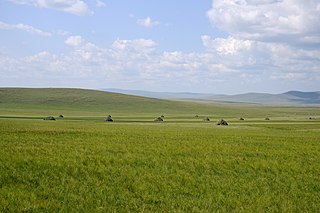
Inner Mongolia, officially the Inner Mongolia Autonomous Region, is an autonomous region of China. Its border includes two-thirds of the length of China's border with the country of Mongolia. Inner Mongolia also accounts for a small section of China's border with Russia. Its capital is Hohhot; other major cities include Baotou, Chifeng, Tongliao, and Ordos.

Outer Mongolia was the name of a territory in the Manchu-led Qing dynasty of China from 1691 to 1911. It corresponds to the modern-day independent state of Mongolia and the Russian republic of Tuva. The historical region gained de facto independence from Qing China during the Xinhai Revolution.
Taiwan is divided into multi-layered statutory subdivisions. Due to the complex political status of Taiwan, there is a significant difference in the de jure system set out in the original constitution and the de facto system in use today.

Jilin is one of the three provinces of Northeast China. Its capital and largest city is Changchun. Jilin borders North Korea and Russia to the east, Heilongjiang to the north, Liaoning to the south, and Inner Mongolia to the west.

Heilongjiang is a province in northeast China. It is the northernmost and easternmost province of the country and contains China's northernmost point and easternmost point.

Chahar, also known as Chaha'er, Chakhar or Qahar, was a province of the Republic of China in existence from 1912 to 1936, mostly covering territory in what is part of Eastern Inner Mongolia. It was named after the Chahar Mongols.

Hohhot, formerly known as Kweisui, is the capital of Inner Mongolia in the north of the People's Republic of China, serving as the region's administrative, economic and cultural center. Its population was 3,446,100 inhabitants as of the 2020 census, of whom 2,944,889 lived in the metropolitan area consisting of 4 urban districts plus the Tumed Left Banner.
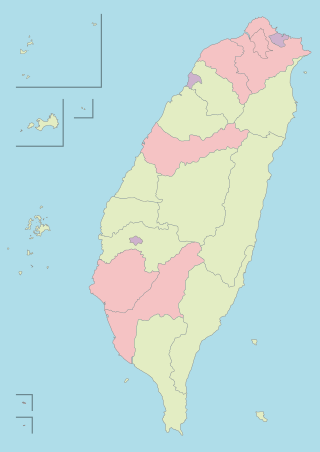
An autonomous municipality, county-level city or city, previously provincial city, is a de jure second-level administrative division unit in the Republic of China (Taiwan).

Fuchien Province, also romanized as Fujian and rendered as Fukien, is a de jure administrative division of the Republic of China (ROC). Provinces remain a titular division as a part of the Constitution of the Republic of China, but are no longer considered to have any practical administrative function.
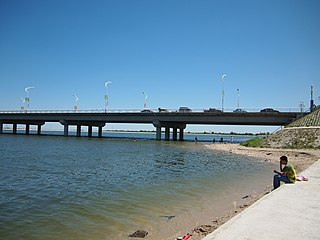
Tongliao is a prefecture-level city in eastern Inner Mongolia, People's Republic of China. The area is 59,535 square kilometres (22,987 sq mi) and as of the 2020 census, its population was 2,873,168. However, the city proper made of Horqin district, had 921,808 inhabitants. The city was the administrative centre of the defunct Jirem League.

Baicheng is a prefecture-level city in the northwestern part of Jilin province, China, bordering Inner Mongolia to the north and west and Heilongjiang to the east and northeast. At the 2010 census, 2,033,058 people lived within its administrative area of 25,683 km2 (9,916 sq mi).

Liaoyuan is a prefecture-level city in Jilin province, People's Republic of China. It is bounded on the west and south by Tieling of Liaoning province, west and north by Siping, and east by Tonghua and Jilin City. Liaoyuan lies some 100 km (62 mi) south of Changchun, the provincial capital. Covering an area of 5,125 km2 (1,979 sq mi), Liaoyuan is the smallest among the prefecture-level divisions of Jilin. Liaoyuan has a total population of 1,176,645 in the prefecture, while the urban area has a population of 462,233.
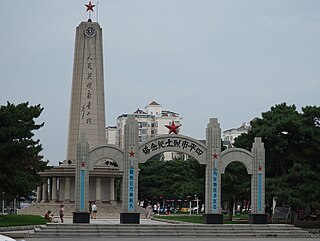
Siping, formerly Sipingjie, is a prefecture-level city in the west of Jilin province, People's Republic of China. It has a total population of 1,814,733 inhabitants, as of the 2020 census. Siping covers an area of 14,323 km2 (5,530 sq mi) and is located in the middle of the Songliao Plain, near the border with Liaoning and Inner Mongolia provinces.
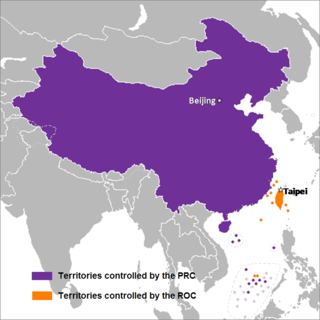
The concept of Two Chinas refers to the political divide between the People's Republic of China (PRC) and the Republic of China (ROC). The PRC was established in 1949 by the Chinese Communist Party, while the ROC was founded in 1912 and retreated to Taiwan after losing the Chinese Civil War.

Shuangliao is a city in western Jilin, People's Republic of China, bordering Liaoning and Inner Mongolia. It is under the administration of Siping City and was previously the de jure capital of the defunct Liaobei Province.

The Tibet Area was a province-level administrative division of China in the 20th century. It was de jure created after the establishment of the Republic of China in 1912, and nominally includes the Ü-Tsang and Ngari areas, but not the Amdo and Kham areas. The territories were merely claimed by the ROC, but actually controlled by an independent Tibet with a government headed by the Dalai Lama in Lhasa. At this time, the scope of de facto independent Tibet included the "Tibet area" and the Chamdo area west of the Jinsha River, which claimed by China. The ROC retreated to Taiwan and lost control of mainland China to the People's Republic of China (PRC) in 1949; afterwards, the ROC continued to claim Tibet.
Songshan is a town under the administration of Panshi City in southern Jilin province, China, situated 46 kilometres (29 mi) from downtown Panshi as the crow flies. In 2011, it had one residential community and ten villages under its administration.
The administrative divisions of China between 1912 and 1949 were established under the regime of the Republic of China government.
Ma Ming is a former Chinese politician who spent his career in northeast China's Jilin province and the nearby Inner Mongolia Autonomous Region. He was investigated by the Central Commission for Discipline Inspection in December 2019. Previously he served as vice chairman of the Inner Mongolia Autonomous Region Committee of the Chinese People's Political Consultative Conference.















